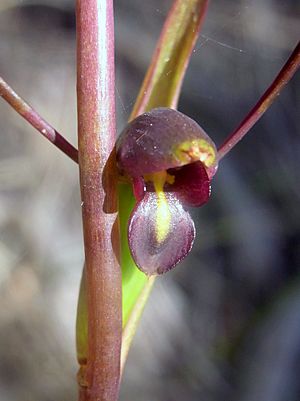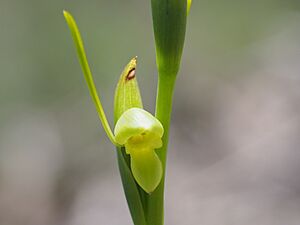Bird's-mouth orchid facts for kids
Quick facts for kids Bird's-mouth orchid |
|
|---|---|
 |
|
| In Ku-ring-gai Chase National Park, Australia | |
| Scientific classification | |
| Genus: |
Orthoceras (plant)
|
| Species: |
strictum
|
The bird's-mouth orchid, also called the horned orchid, is a special type of orchid. Its scientific name is Orthoceras strictum. This plant naturally grows in eastern and southern Australia, New Zealand, and New Caledonia.
It usually has two to five long, thin leaves. Its flowers are often yellowish-green, brownish, or even blackish. Each flower has two long, horn-like parts called sepals that stand up or spread out.
What Does It Look Like?
The bird's-mouth orchid is a plant that grows from the ground. It's a perennial plant, meaning it lives for more than two years. It's also deciduous, so its leaves fall off at certain times. This plant has an underground tuber, which is like a small storage organ.
It grows a bunch of two to five leaves that look like grass. These leaves are about 150 to 300 millimeters (6 to 12 inches) long and 2 to 3 millimeters (about 0.1 inches) wide.
The plant sends up a stiff stem that is 300 to 600 millimeters (12 to 24 inches) tall. On this stem, you can find up to nine flowers. Each flower is about 8 to 10 millimeters (0.3 to 0.4 inches) wide. The flowers can be blackish, brownish, maroon, or yellowish-green.
The top part of the flower, called the dorsal sepal, is shaped like an egg. It forms a hood over the rest of the flower. This part is about 9 to 12 millimeters (0.35 to 0.47 inches) long. The two side sepals are long and look like horns. They are about 20 to 25 millimeters (0.8 to 1 inch) long. These "horns" can stand straight up, spread out, or be slightly curved.
Inside the flower, hidden by the top sepal, are the petals. They are about 8 to 10 millimeters (0.3 to 0.4 inches) long. The labellum is a special lip-like part of the flower. It's 6 to 10 millimeters (0.24 to 0.4 inches) long and has three parts, or lobes. There's also a small, pyramid-shaped bump called a callus near the base of the labellum.
These orchids usually bloom from November to February.
How It Got Its Name
The bird's-mouth orchid was first officially described in 1810. A botanist named Robert Brown wrote about it in his book Prodromus Florae Novae Hollandiae et Insulae Van Diemen.
The first part of its scientific name, Orthoceras, comes from two Ancient Greek words. "Orthos" means "straight," and "keras" means "horn." This name refers to the straight, horn-like side sepals of the flower.
The second part of the name, strictum, is a Latin word. It means "straight" or "tight." This also points to the straight shape of parts of the plant.
Where It Lives
The bird's-mouth orchid is found in many places, but it's not very common. You can find it in several Australian states, including New South Wales, Queensland, South Australia, Tasmania, and Victoria. It also grows in New Caledonia.
This orchid can live in many different environments. It grows in grassy forests and also in areas with low, shrubby plants called heathlands. There's another similar orchid called Orthoceras novae-zeelandiae found in New Zealand. Scientists say the differences between these two species are very small and hard to tell apart.
Protecting This Orchid
In Tasmania, the Orthoceras strictum is listed as "rare." This means it's not very common and needs protection. It's listed under the Tasmanian Government's Threatened Species Protection Act 1995. This law helps protect plants and animals that are at risk.


